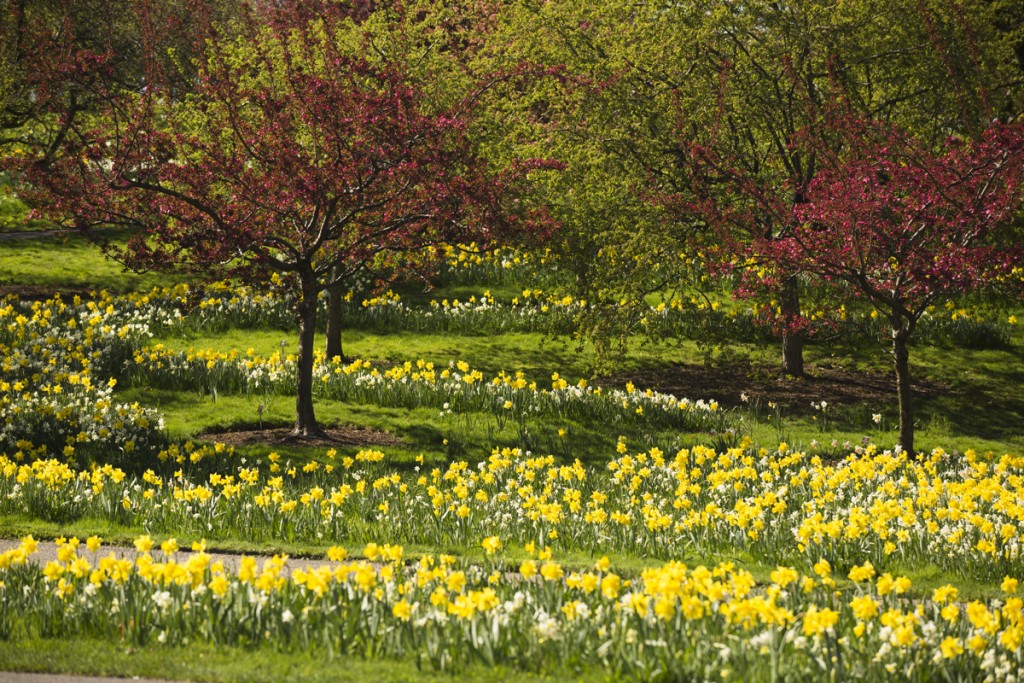Manhattan Goes Dutch in the Spring
From our Spring, 2023 Newsletter
by Ina Lee Selden
Never is Manhattan more Dutch than in April. That’s when the multi- billions of Dutch daffodils and countless tulips bloom in almost every available pot, box, median and mall.
Every year, the Fund for Park Avenue plants 66,000 tulips from 56th to 86th Streets. Just to the north, the Carnegie Hill Neighbors continue the plantings from 86th to 96th Street with about 22,000 bulbs. The two organizations coordinate their plantings. The purple Darwin Hybrid is this year’s choice. The Darwin is one of the few varieties able to survive the traffic, weather extremes, and other challenges nature faces in the middle of a main thoroughfare of Manhattan.

Spring in New York unofficially begins when the Park Avenue tulips bloom. The underground rail lines beneath the avenue heat the ground and give the bulbs and New Yorkers a head start on the season. In mid-May, when the leaves yellow, the Fund invites the public to its annual BYOS (Bring Your Own Shovel) Big Dig to gently gather the bulbs. The following fall, those 66,000 bulbs find their way into tree pits, flower boxes and front and backyard gardens.
In 2009, to celebrate the 400th anniversary of the arrival of Henry Hudson into today’s New York Harbor, the Orange Blushing Apeldoorns, Darwin Hybrids, filled the Park Avenue malls.
For its part, the New York City Parks Department plants 90,000 tulips throughout the city each year. At the Conservatory Garden, 105th Street and Fifth Avenue, with half the garden under renovation, “only” 10,000 will grace the garden this spring.
Since 2015, the New York Botanical Garden has added more than 750,000 bulbs to Daffodil Hill. We can expect 10,000 more in 2024. The Narcissus Dutch Master Trumpet is the NYBG’s daff of choice. In 2001, after the attack on the World Trade Center, the Dutch daffodil supplier Hans van Waardenburg donated 1,000,000 daffodil bulbs to New York City to honor the tragedy’s victims. More than 400,000 volunteers helped plant the bulbs.
Daffodil bulbs proliferate underground. One bulb becomes two its second year, two become four the third, explains Anton Van de Wetering, whose immigrant father started growing bulbs on Long Island 50 years ago. The firm has planted and maintained Park Avenue’s tulips since the 1950’s. Assuming doubling every year, this year’s yield from that initial gift might be 1,065,728,000,000. Van de Wetering cautions that not all bulbs will reproduce: “Even a scratch can doom them.” Splashes from street water can be murder.”
No matter. Even if the yield is “only” half that trillion, the first gift inspired the creation of the non-profit Daffodil Project in 2002. Since then, the project’s volunteers have distributed more than nine million bulbs to honor the victims of 9/11 and Covid 19.
It’s no wonder New York seems to float on a sea of tulips and daffodils each spring.
We hope you’ve enjoyed our articles and information. If you would like to contribute to help us promote and spread the history of the early New York, please click and discover more about our programs, what we offer and ways you can help.
To be a sponsor email us at: [email protected]




